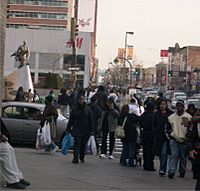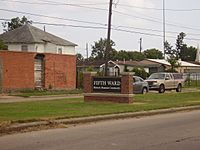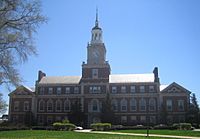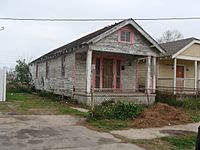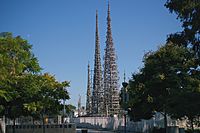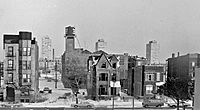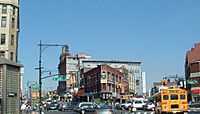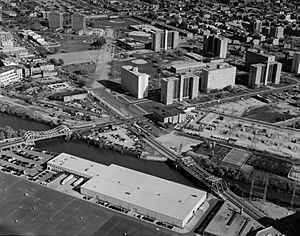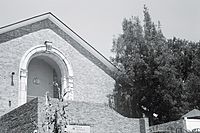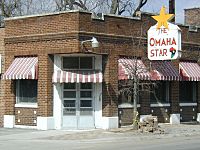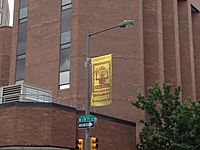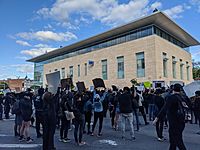African-American neighborhood facts for kids
African-American neighborhoods are areas in cities where most people living there are Black. These neighborhoods are found in many cities across the United States. Some of the very first ones were in places like New Orleans, Mobile, Atlanta, and other cities in the South. New York City also had a large Black population early on. For example, in 1830, about 14,000 "free Black people" lived in New York City.
The way Black neighborhoods formed is closely tied to the history of segregation in the U.S. This segregation happened either through official laws or through social rules. Even with these challenges, Black neighborhoods have been very important for developing African-American culture.
Today, Black people are moving to different areas, and there is less segregation. Many Black people are now moving to suburbs. However, Black people still often live in poorer neighborhoods compared to white people and other racial groups in America.
Contents
History of Black Neighborhoods
The Great Migration (1914-1940)
The Great Migration was a huge movement of over one million African Americans from the rural Southern United States between 1914 and 1940. Most of them moved to big industrial cities in the North and West. These cities included New York City, Chicago, Philadelphia, Detroit, Cleveland, St. Louis, Los Angeles, and Washington, D.C.. This movement greatly helped create and expand Black neighborhoods in these cities. For example, Chicago's South Side is now one of the largest mostly Black areas in America.
While the Great Migration helped some educated Black people find jobs and improve their lives, many faced serious challenges. Working-class people in the North sometimes felt threatened by the new arrivals. They worried about losing jobs or having their pay lowered.
Cities grew very quickly with both Black migrants and new European immigrants. This led to a big shortage of housing. New groups often had to compete for the oldest and most run-down houses because that was all they could afford. Black Americans often competed with immigrants for both jobs and housing.
People who had lived in cities longer and had more money often moved to newer homes on the edges of cities. They wanted to get away from the crowded conditions caused by the new residents.
Migrants also found that the open discrimination they faced in the South was still present in the North, but in more hidden ways. In 1917, the Supreme Court said that city laws forcing segregation were against the law. In response, some white groups used "restrictive covenants." These were formal agreements that property owners made not to sell their homes to Black people. If someone broke these agreements, their neighbors could sue them. It wasn't until 1948 that the Supreme Court made these agreements illegal. Also, the National Housing Act of 1934 made it harder for Black people to get loans for homes in certain city areas.
Sometimes, the large number of Black migrants and other immigrants led to racial violence. This happened in several cities in 1919.
The famous artist Jacob Lawrence created his Migration Series of paintings about this important event. His art showed the struggles of Black migrants adapting to Northern cities. This series made him one of the most important African-American artists of his time.
The Second Great Migration (1940-1970)
From 1940 to 1970, another five million Black people left the South. They moved to cities in the North and West to find industrial jobs. Sometimes, this movement led to violence.
As more Black people moved from the South, banks, insurance companies, and businesses started "redlining." This meant they would deny or make services more expensive for people in certain areas, often based on race. For example, it was harder to get mortgage loans in these areas. This led to a big increase in racial segregation and urban decay in U.S. cities.
"Urban renewal" also shaped Black neighborhoods. This was a process of redeveloping areas within large cities. It started in the late 1940s and still happens today. Urban renewal often involved tearing down homes and businesses and moving people. Cities would use eminent domain to take private property for new projects. Reasons for urban renewal often included getting rid of "slums" or "blighted" areas.
However, urban renewal often led to urban sprawl. Large parts of cities were torn down and replaced by freeways, housing projects, or empty lots. Urban renewal had a very negative impact on Black neighborhoods. In the 1960s, writer James Baldwin called it "Negro Removal."
Building highways sometimes cut off and isolated Black neighborhoods from stores and services. For example, Birmingham's highway system helped keep racial boundaries that were set by a 1926 zoning law. Building highways through Black neighborhoods led to many people moving out and increased racial segregation.
Riots in cities across the country from 1964 to 1968 also damaged many areas. Examples include Detroit's 12th Street and parts of Washington, D.C., and Harlem in New York City during the Harlem Riots. In 1968, the Civil Rights Act made racial restrictions on housing illegal. This allowed middle-class Black Americans to move to better homes, sometimes in the suburbs, and to desegregated neighborhoods. But in some areas, real estate agents still illegally guided Black Americans to certain areas.
Late 20th Century Changes
By 1990, the laws that forced segregation were gone. However, a different kind of racism remained. White people sometimes paid more to live in mostly white areas. Some experts say that the growth of suburbs and the movement of people out of city centers are examples of white privilege. These trends have led to today's patterns of environmental racism.
At the same time, many middle-class and upper-class Black people also moved to the suburbs. They left the inner cities of former industrial areas. In what is called the New Great Migration, Black college graduates are now moving back to the South for jobs. They often settle in middle-class suburban areas. This includes states like Texas, Georgia, and Maryland.
Black Neighborhoods Today
Even with many changes, the United States still has a lot of residential segregation. Black and white people often live in different neighborhoods that have very different qualities. Cities have always had distinct ethnic areas. But Black neighborhoods in U.S. cities today are often more isolated and have more poverty than other groups.
Black Middle Class and Professional Areas
See Gentrification in the United States for how Black neighborhoods are changing.
Thanks to the Civil Rights Movement, the Black community has seen a rise in middle-class and professional Black people. This has led to many neighborhoods where most residents are Black and are also middle to upper class. Many of these communities are found in the suburbs of Washington, D.C., and Baltimore, Maryland. They are also common in the suburbs of Atlanta, Georgia, and in places like Cedar Hill, Texas, Oak Park, Michigan, and LaPlace, Louisiana. People in these communities are often highly educated and work in professional jobs.
Even in cities that have traditionally had high poverty, some neighborhoods have developed with middle-class and wealthy Black residents. City policies like "gentrification" have also played a role. Gentrification is when a neighborhood is improved to fit middle-class tastes.
Understanding "Ghettos"
Racial segregation in the United States is most clear in housing. Even if people of different races work together, they often do not live in truly mixed neighborhoods. This pattern is similar in most cities.
Because of segregation and widespread poverty, some Black neighborhoods in the U.S. have been called "the ghetto" or "the projects." Using these terms can be controversial and sometimes offensive. However, while many people use "ghetto" to mean a poor urban area, those who live there often use it in a positive way.
Black "ghettos" were not always full of broken-down houses or poor people. For many Black Americans, the "ghetto" was "home." It was a place that represented real Black culture. It also showed a feeling of strength and pride that came from overcoming the struggles of being Black in America.
The poet Langston Hughes wrote about this in "The Heart of Harlem" (1945): "The buildings in Harlem are brick and stone/And the streets are long and wide,/But Harlem’s much more than these alone,/Harlem is what’s inside." Playwright August Wilson used the term "ghetto" in his plays, drawing on his own childhood in the Hill District of Pittsburgh. Depending on the situation, terms like "ghetto" or "hood" (short for neighborhood) can be used with affection for where someone grew up or lives.
Important Places in Black Neighborhoods
Some Black neighborhoods might not get as much investment from the city. Schools might be seen as lower quality, and policing or fire protection might not be as effective. However, there are many important places that help improve these neighborhoods. As more Black Americans have moved up in society, many communities now have better schools and safe neighborhoods. These issues are often more about money than race, as middle-class Black people in middle-class neighborhoods tend to have better schools and safer areas.
Churches
In Black neighborhoods, churches have been very important for bringing people together and for social action. For some Black Americans, the spiritual lessons from these churches help protect them from the harmful effects of racism. Churches also work to improve the neighborhood itself. Churches in Harlem have bought and fixed up old buildings to create new homes for residents. Churches have also fought for the right to run their own schools instead of the often poor public schools in some Black neighborhoods.
Museums
The African American Museum Movement started in the 1950s and 1960s. Its goal was to save the history of the Black experience and make sure it was correctly understood in American history. Museums about African American history are found in many Black neighborhoods. Places like the African American Museum and Library at Oakland, the Charles H. Wright Museum of African American History in Detroit, and the DuSable Museum in Chicago were created by Black Americans. They teach and explore cultural history that was mostly passed down through stories until recent times.
Theatre and Arts
Major movements in literature, music, and art started in African American neighborhoods. These include Blues, Gospel, Jazz, Soul, Rap, House, and Rock 'n' roll. Cities were places where young artists could meet, study with others, and become famous. For example, Jacob Lawrence's "Migration Series" was shown at the Museum of Modern Art in New York when he was only in his 20s.
African American neighborhoods have also created Black theater and many dance companies. After his career as a classical ballet dancer, Arthur Mitchell started a school and dance company in Harlem. Alvin Ailey created dances based on the African American experience with his Alvin Ailey Dance Company.
Chicago stepping is a dance that started in Chicago's mostly Black neighborhoods. House music, a type of Electronic Dance Music, was first developed in Chicago in the early 1980s. By the 1990s, it had spread around the world.
Hip hop is both a cultural movement and a music style. It started in New York City in the late 1970s, mostly by Black people. Since it first appeared in the South Bronx and Bedford-Stuyvesant, the rap/hip hop lifestyle has spread globally.
Newspapers
Many African American neighborhoods have their own newspapers. These include the South Fulton Neighbor in Atlanta, the Capitol Update in Tallahassee, the Chicago Defender in Chicago, the Amsterdam News in New York City, and the Star in Omaha.
Education
Segregation in schools led to the creation of many Black schools. These included public elementary, junior, and senior high schools across the U.S. during the time of legal segregation. Students at these schools could take vocational classes or regular high school courses. On the college level, a few historically Black colleges and universities started before the Civil War. Many more were created after 1865. These colleges and universities are often surrounded by Black neighborhoods.
Festivals and Holidays
In Philadelphia, the Odunde Festival (also called "African New Year") is said to be the largest gathering of African Americans. It happens every year on the second Sunday of June in the Southwest Center City area.
Also, Washington, D.C. celebrates April 16 as Emancipation Day. This is a public holiday that remembers the freedom of enslaved people of African origin.
Juneteenth has become more popular nationally and internationally. This holiday started among Black Texans in Galveston, Texas. Enslaved people there learned about the Emancipation Proclamation two years late because slaveholders had hidden the information from them. Today, many Black communities in Texas and beyond celebrate June 19 as a complex but joyful holiday. It is also known as Jubilee Day.
Types of Buildings in Black Neighborhoods
Many African American neighborhoods are in inner cities or urban centers. These are mostly residential areas closest to the main business district. The buildings are often 19th- and early 20th-century row houses or brownstones. There are also older single-family homes that might have been turned into multi-family homes. In some areas, there are larger apartment buildings.
Shotgun houses are an important type of building in some southern African American neighborhoods. These houses have three to five rooms in a row with no hallways. This house design is found in both rural and urban southern areas, especially in Black communities and neighborhoods (like in New Orleans).
The name "shotgun house" is often said to come from the idea that you could fire a shotgun through the front door, and the pellets would fly straight through the house and out the back door. However, the name might actually come from African architectural heritage. It could be a changed version of a term like to-gun, which means "place of assembly" in the Southern Dohomey Fon area.
During times of population decline and urban decay in the 1970s and 1980s, many African American neighborhoods, like other urban minority neighborhoods, turned abandoned lots into community gardens. Community gardens serve important social and economic purposes. They provide safe, open spaces in areas with few parks. Organizations like Philadelphia Green have helped communities create gardens to build community spirit and improve neighborhoods. These gardens can be places for people to socialize, get fresh vegetables (especially in neighborhoods without many supermarkets), and grow traditional African American produce.
See Also
- Gentrification in the United States
- Redlining
- Racial segregation in the United States
Images for kids


